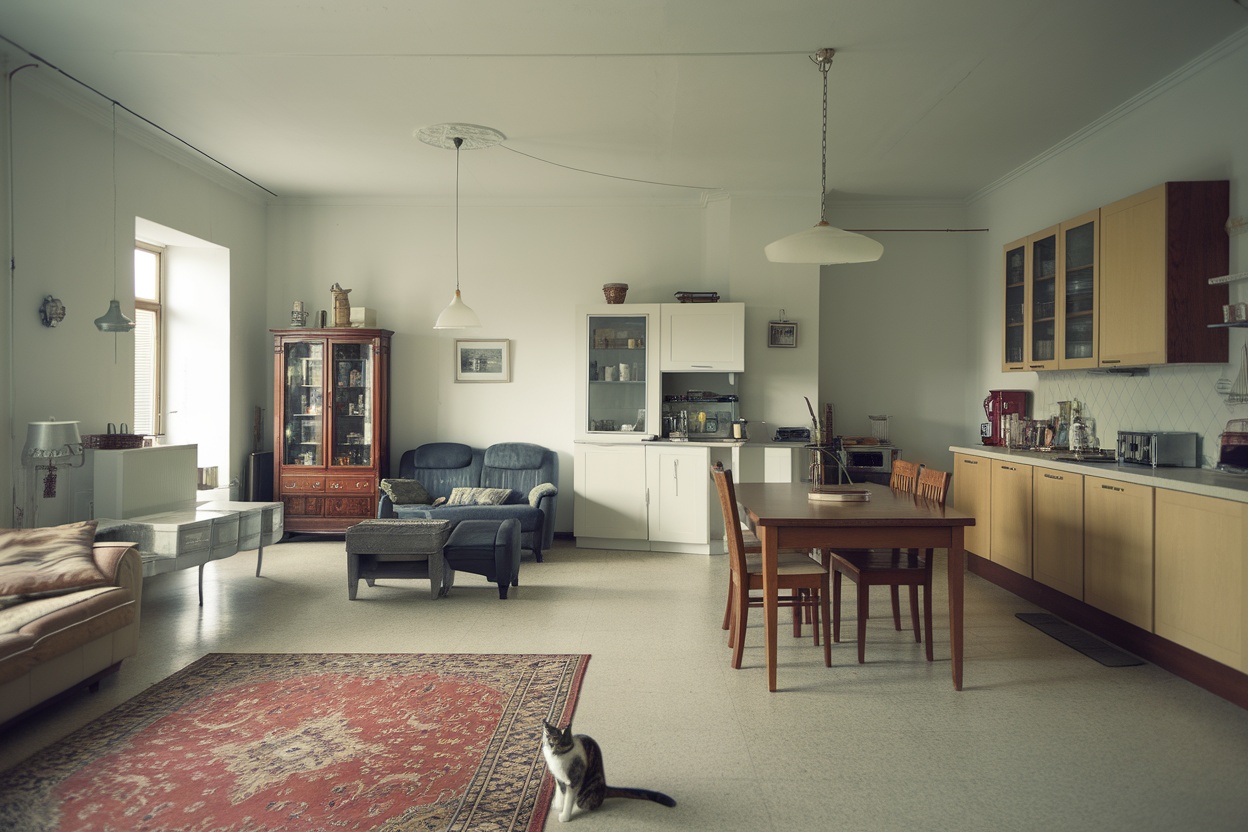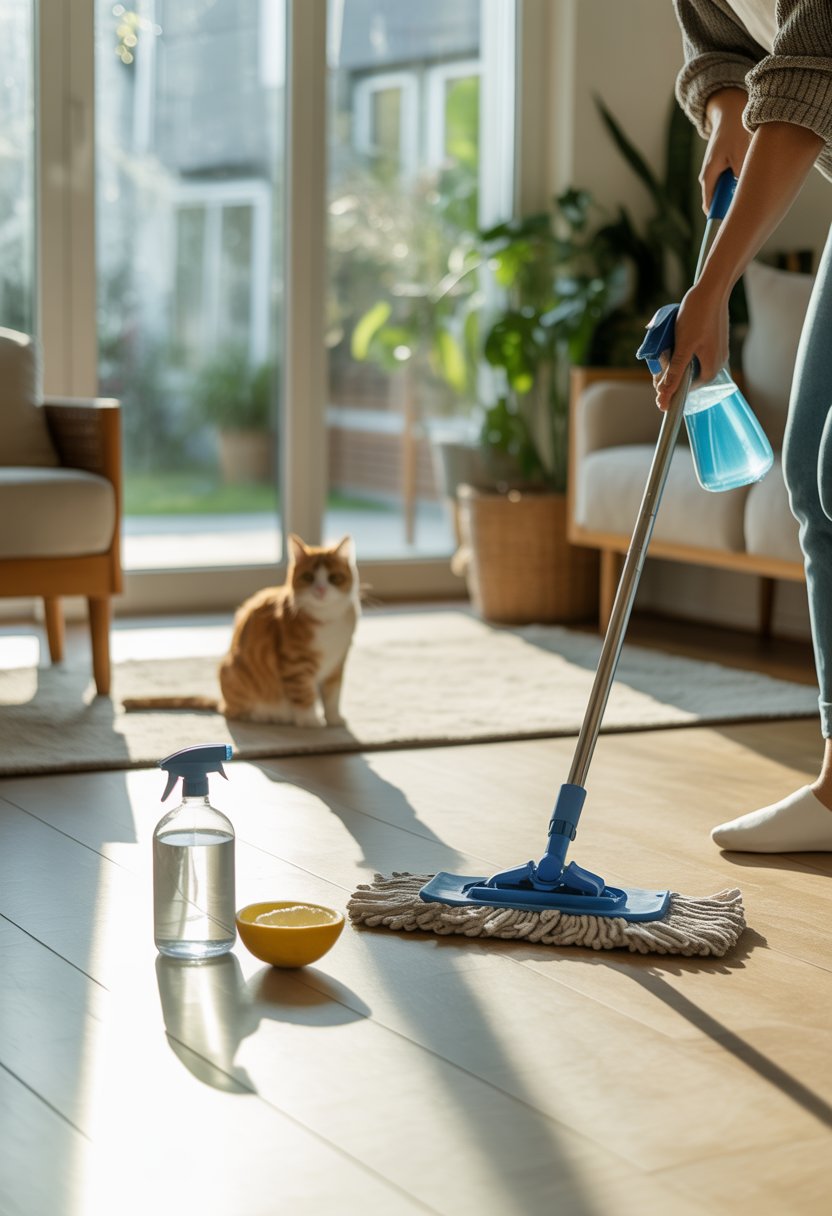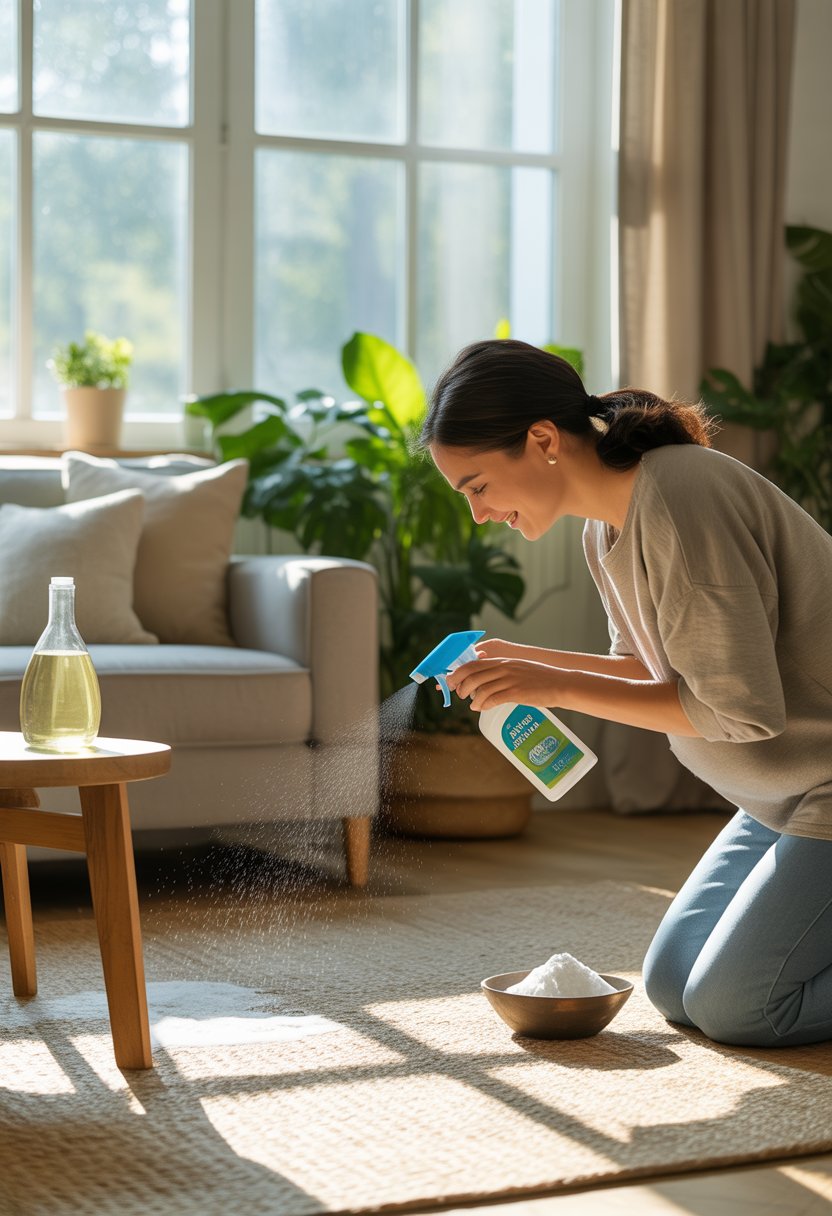
Cat pee smell can totally take over your home, making it pretty uncomfortable for you and anyone who visits. That strong ammonia odor just gets worse as time goes on, spreading to other rooms if you don’t tackle it fast.
You can remove cat pee smell from your whole house using natural ingredients like white vinegar, baking soda, and enzyme cleaners made from everyday items. These natural solutions work as well as harsh chemicals, but they’re a lot safer for your family and pets.
Getting rid of cat pee smell isn’t a one-size-fits-all thing. You need different methods for carpets versus hardwood, and some spots just need extra attention to keep the odor from coming back.
Understanding Cat Pee Odor in Your Home
Cat urine contains strong compounds that really cling to surfaces, making them harder to get rid of the longer you wait. The smell creeps into carpets, furniture, and even walls, and it can cause health concerns if you ignore it.
Why Cat Pee Smell Lingers
Cat urine is stubborn because of three main components. Urea breaks down into ammonia, which is that sharp, unmistakable smell you notice right away.
Urochrome gives urine its yellow tint and adds to the overall stench. The third part, uric acid, forms crystals that stick around.
These uric acid crystals are the real headache. They don’t dissolve in water, so they bond tightly to carpet fibers, wood, and fabric.
If the air gets humid or the area gets wet, those crystals wake up and the smell comes back. That’s why you might notice cat urine again on muggy days, even after cleaning.
Regular cleaners can’t do much against uric acid crystals. They might cover up the smell for a bit, but the source stays put. Only enzyme-based cleaners can actually break these compounds down.
Common Areas Affected by Odor
Carpets and rugs soak up urine fast, letting it reach the padding below. The padding holds onto moisture and odor much longer than the top layer.
Hardwood floors might seem easy, but urine seeps into the wood grain and can even reach the subfloor if you don’t act quickly.
Furniture like couches and chairs trap the smell in cushions and fabric. Leather furniture isn’t immune—it absorbs urine into its pores.
Walls and baseboards near litter boxes often get splashed. The smell can soak into paint and drywall.
Concrete floors in basements or garages are super porous and lock in odor deep down. The alkaline nature of concrete can make the ammonia smell even worse.
Health Impacts of Lingering Odors
Ammonia from cat urine can irritate your respiratory system. You might cough, get a scratchy throat, or even have trouble breathing if you’re exposed for too long.
Children and elderly people are especially sensitive to these effects. They can develop symptoms faster than healthy adults.
The smell can trigger headaches and nausea. Strong odors also make asthma and other breathing issues worse.
Bacteria grows around contaminated spots, which can cause infections if it touches open wounds.
Living with bad smells just isn’t good for your mind, either. It adds stress and makes your home feel dirty. Friends might not want to visit, which can get a little isolating.
Natural Cleaning Steps for Removing Cat Pee Smell
If you act fast, you’ll keep urine from sinking deeper and becoming a bigger hassle. Basic household stuff like white vinegar, baking soda, and hydrogen peroxide can knock out odors naturally.
Immediate Actions to Take
Blot fresh urine right away with paper towels or a clean cloth. Press down hard to soak up as much as you can. Don’t rub or scrub—just makes things worse.
Use gloves to pick up any solids. Toss contaminated stuff in sealed bags.
Check for dryness by pressing a clean towel onto the spot. Keep blotting until nothing comes up.
Mark the spot with chalk or tape if you need to come back later. It’s easy to lose track of where the problem is.
Open windows and turn on fans to get air moving. Fresh air really helps reduce the smell while you get your cleaning stuff together.
Effective Homemade Cleaning Solutions
White vinegar solution is a go-to for most surfaces. Mix equal parts white vinegar and water in a spray bottle. Spray the area and let it sit for 10 minutes, then blot.
Baking soda paste is great for carpets. Combine 3 parts baking soda with 1 part water. Smear it on the stain and let it dry before vacuuming.
Hydrogen peroxide mix breaks down urine compounds. Mix 1 cup hydrogen peroxide, 1 teaspoon dish soap, and 2 tablespoons baking soda. Always test a hidden spot first.
| Solution | Best For | Application Time |
|---|---|---|
| Vinegar mix | Hard surfaces | 10 minutes |
| Baking soda paste | Carpets | 8-12 hours |
| Peroxide mix | Fabric/upholstery | 15 minutes |
Enzyme Cleaners and Their Natural Alternatives
You can make a citrus enzyme cleaner by mixing orange peels, brown sugar, and water in a jar. Let it ferment for about 3 months, giving it a shake every week or so.
A yogurt-based solution uses natural enzymes to break down odor. Mix 2 tablespoons plain yogurt with 1 cup warm water, apply, and let it sit for half an hour.
Pineapple juice has bromelain, which breaks down proteins. Just pour fresh juice on the stain, leave it for 20 minutes, then rinse with water.
These natural options work a bit slower than commercial enzyme cleaners, but they skip harsh chemicals. You might need to repeat the process for older or tougher stains.
Addressing Soft Surfaces: Carpets, Rugs, and Upholstery
Soft surfaces are a pain because they soak up cat urine deep into their fibers. White vinegar can neutralize ammonia, and baking soda pulls moisture and smells out of fabrics.
Treating Carpets with Vinegar and Baking Soda
Blot up fresh urine with paper towels first. Press hard to soak up as much as possible. Don’t rub—it just sends the urine deeper.
Mix equal parts white vinegar and water in a spray bottle. Spray the area until it’s damp, not drenched.
Let the vinegar mix sit for 10 minutes. Vinegar’s acid breaks down those stubborn uric acid crystals.
Blot again with clean towels. While the carpet’s still damp, sprinkle baking soda over the spot.
For older stains:
- Use undiluted vinegar
- Let it sit 15–20 minutes
- Add extra baking soda
Leave the baking soda on overnight. It’ll soak up leftover moisture and odor. Vacuum up the next day.
Deodorizing Upholstery Using Natural Ingredients
Check your furniture’s cleaning code before you start. “W” means water-based cleaners are safe, “S” means use solvents only.
For water-safe upholstery, mix 1 cup water, 1/2 cup white vinegar, and 2 tablespoons dish soap.
Always test on a hidden spot first. Wait a day to see if anything changes.
Dab the solution on urine spots with a clean cloth. Don’t scrub—just dab from the outside of the stain in.
Natural enzyme option:
- 1 cup warm water
- 1/4 cup vinegar
- 1 tablespoon salt
- 1 tablespoon dish soap
Rinse with a damp cloth and plain water. Use a fan to help it dry and keep mold away.
Deep Cleaning Area Rugs Without Chemicals
Take small rugs outside if you can. Hose them down to get rid of loose urine.
Mix up a paste with 3 parts baking soda and 1 part water. Scrub it into stains with a brush.
Let it dry in the sun—UV light helps break down the stink. Four to six hours usually does it.
For big rugs you can’t move, use the carpet method above. Work in sections so you don’t soak the backing.
Drying steps:
- Shake out dried baking soda
- Vacuum up the rest
- Air dry all the way before bringing it back in
If the smell sticks around, repeat the process. Some old stains just need a second (or third) round.
Deodorizing Hard Surfaces and Floors

Hard surfaces like wood and tile need their own game plan. White vinegar and baking soda are your best bet for breaking up urine crystals and getting rid of odors on these surfaces.
Cleaning Wood and Tile Floors Naturally
Mix equal parts white vinegar and warm water in a spray bottle. Add about 10 drops of dish soap to help it cling to the floor.
Spray the mix right onto the spot. Let it sit for 5 minutes to start breaking up those crystals.
Wipe with a clean microfiber cloth. If it’s stubborn, scrub gently with a soft brush.
For wood floors: Use less water and dry the area right away to avoid damage.
For tile: Scrub grout lines with an old toothbrush—urine loves to hide there.
Rinse with clean water and dry well. That’ll keep the vinegar smell from hanging around.
Neutralizing Cat Pee Odor on Hard Surfaces
Once the spot’s clean and dry, sprinkle baking soda over it. Baking soda soaks up any lingering smells.
Let it sit for a few hours—overnight if it’s really bad.
Vacuum or sweep up the baking soda. Wipe away any leftover powder with a damp cloth.
For tough spots, make a baking soda paste with a little water. Let it dry, then clean it up.
Hydrogen peroxide solution: Mix 1 part 3% hydrogen peroxide with 2 parts water. Always test a hidden spot first.
Spray the peroxide solution, let it bubble for half a minute, then wipe clean.
Freshening the Air and Maintaining a Clean Environment

You can use natural air purifiers like plants and charcoal to help chase away lingering cat urine smells. DIY sprays with essential oils give your home a fresh scent without nasty chemicals.
Using Natural Air Purifiers
Activated charcoal is awesome for absorbing odors. Put bowls of it around the room and swap them out every couple of weeks.
Baking soda also grabs odors from the air. Leave open containers in corners and under the couch. Change it out once a month.
Plants like snake plants, spider plants, and peace lilies naturally clean the air. Set them up in rooms where your cat hangs out.
White vinegar can help neutralize ammonia smells. Pour some in bowls and leave them around the house. The vinegar scent fades but keeps working.
Used coffee grounds can soak up odors too. Spread them on a plate, leave them overnight, and swap them out each day for best results.
DIY Air Freshening Sprays
Mix 2 cups water with 1 tablespoon white vinegar and 10 drops lavender essential oil. Spray this in the air—avoid spraying it directly on surfaces.
You can whip up a citrus spray by combining 2 cups water, 1 teaspoon lemon juice, and 5 drops orange essential oil. That blend really knocks out ammonia odors.
Want something stronger? Try mixing 1 cup water, 1 tablespoon vodka, and 15 drops eucalyptus oil. The vodka helps the scent stick around longer, which is handy.
Peppermint oil spray is another great option. Just stir together 2 cups water and 8 drops peppermint oil. It’s sharp, fresh, and covers lingering smells pretty well.
Test these sprays in a small area first, just to be safe. Oils and water don’t stay mixed, so give the bottle a good shake every time.
Improving Ventilation for Odor Control
Open your windows when you can and let some fresh air in. If you open windows on both sides of a room, you’ll get a nice cross-breeze.
Ceiling fans keep air moving, pushing out stale smells and pulling in the good stuff. I usually run fans for a few hours in rooms that need it.
Exhaust fans in bathrooms and kitchens pull out humid air that traps odors. After cleaning litter boxes nearby, let the fan run for about 30 minutes.
Air purifiers with HEPA filters trap those little particles that carry smells. Set one up where your cat tends to pee the most.
Check your HVAC filters every month. Dirty filters just spread smells around, so swap them out every three months—or sooner if they’re gross.
Preventing Future Cat Accidents and Odor Buildup
Stopping cat accidents before they happen? That’ll save you a ton of hassle. Clean litter boxes, less stress, and proper training all help keep accidents to a minimum.
Identifying Common Triggers for Cat Accidents
Medical issues often lead to accidents outside the litter box. Things like urinary tract infections, kidney disease, or diabetes make cats pee more. Arthritis can make it tough for older cats to get into high-sided boxes.
If your cat suddenly starts having accidents, take them to the vet. Painful urination can make them avoid the box altogether.
Stress triggers include:
- Moving to a new home
- New pets or people in the house
- Loud noises or construction
- Changes in daily routine
- Dirty or moved litter boxes
Cats sometimes mark territory when they catch the scent of other animals. Males do this more than females, even if they’re neutered.
If you’ve got multiple cats, they’ll compete for litter box space. Each cat really needs their own box, plus an extra.
Training and Behavioral Adjustments
Put litter boxes somewhere quiet and easy to reach. Skip the basement, closets, or spots near loud machines. Cats want privacy, but not a maze.
Reward your cat with treats or praise right after they use the litter box. Positive reinforcement goes a long way.
Never punish accidents. Clean up thoroughly and block off the area if you have to. Punishing just stresses them out and makes things worse.
Try Feliway diffusers or calming sprays if your cat seems anxious. Those mimic natural pheromones and can help them relax.
Keep litter boxes on every floor, especially if you have an older cat. They’ll appreciate not having to trek too far.
Maintaining Litter Box Hygiene
Scoop out waste every day. That way, odors stay under control and your cat won’t start searching for a new bathroom spot.
If you’re using clay litter, swap it all out once a week. Clumping litter can stretch a bit longer, but honestly, you should still dump everything and refresh it every couple of weeks.
Weekly cleaning routine:
- Dump out all the old litter.
- Scrub the box with mild soap and water.
- Make sure you rinse and dry the box thoroughly.
- Pour in about 2-3 inches of fresh litter.
Skip the bleach and harsh cleaners. Those strong smells might drive your cat away from the box entirely.
Go ahead and replace the entire box every 6-12 months. Over time, plastic gets scratched up and starts holding onto odors no matter how much you clean.
Try to keep litter boxes in the same spot. Moving them around just confuses your cat and, let’s be honest, leads to messes you’d rather avoid.

